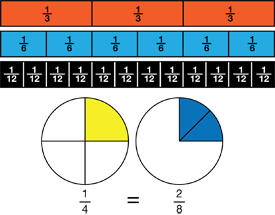Students find equivalent fractions using their fraction charts from Lesson 4 and the fraction circle pieces. They write number sentences to represent the equivalent fractions and look for patterns in the number sentences. They use these patterns to develop other ways to find equivalent fractions.
Content in this Lesson
- Representing fractions using area models including fraction strips and circle pieces [E1].
- Finding equivalent fractions using area models and number lines [E8].
- Finding equivalent fractions using multiplication and division strategies [E8].
- Representing fraction comparisons with symbols (e.g., <, >, =) [E7].
Daily Practice and Problems Y–BB
Assessment in this Lesson
| Assessment | Expectation Assessed |
|---|---|
|
Equivalent Fractions Quiz |
|














